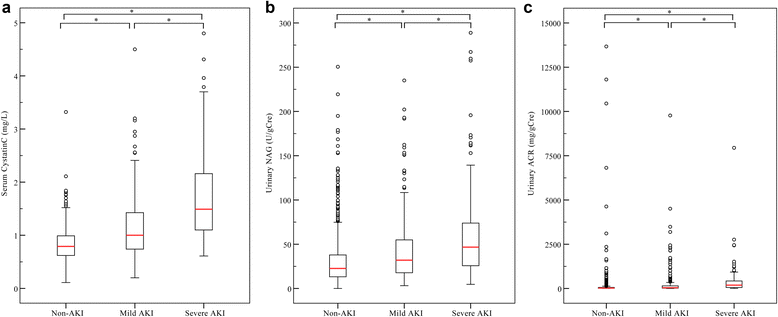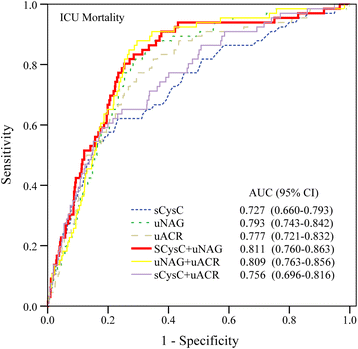Evaluation of clinically available renal biomarkers in critically ill adults: a prospective multicenter observational study
- PMID: 28264714
- PMCID: PMC5339963
- DOI: 10.1186/s13054-017-1626-0
Evaluation of clinically available renal biomarkers in critically ill adults: a prospective multicenter observational study
Abstract
Background: Although serum cystatin C (sCysC), urinary N-acetyl-β-D-glucosaminidase (uNAG), and urinary albumin/creatinine ratio (uACR) are clinically available, their optimal combination for acute kidney injury (AKI) detection and prognosis prediction remains unclear. We aimed to assess the discriminative abilities of these biomarkers and their possible combinations for AKI detection and intensive care unit (ICU) mortality prediction in critically ill adults.
Methods: A multicenter, prospective observational study was conducted in mixed medical-surgical ICUs at three tertiary care hospitals. One thousand eighty-four adult critically ill patients admitted to the ICUs were studied. We assessed the use of individual biomarkers (sCysC, uNAG, and uACR) measured at ICU admission and their combinations with regard to AKI detection and prognosis prediction.
Results: AUC-ROCs for sCysC, uNAG, and uACR were calculated for total AKI (0.738, 0.650, and 0.683, respectively), severe AKI (0.839, 0.706, and 0.771, respectively), and ICU mortality (0.727, 0.793, and 0.777, respectively). The panel of sCysC plus uNAG detected total and severe AKI with significantly higher accuracy than either individual biomarkers or the other two panels (uNAG plus uACR or sCysC plus uACR). For detecting total AKI, severe AKI, and ICU mortality at ICU admission, this panel yielded AUC-ROCs of 0.756, 0.863, and 0.811, respectively; positive predictive values of 0.71, 0.31, and 0.17, respectively; and negative predictive values of 0.81, 0.97, and 0.98, respectively. Moreover, this panel significantly contributed to the accuracy of the clinical models for AKI detection and ICU mortality prediction, as measured by the AUC-ROC, continuous net reclassification index, and incremental discrimination improvement index. The comparable performance of this panel was further confirmed with bootstrap internal validation.
Conclusions: The combination of a functional marker (sCysC) and a tubular damage marker (uNAG) revealed significantly superior discriminative performance for AKI detection and yielded additional prognostic information on ICU mortality.
Keywords: Acute kidney injury; Intensive care unit; N-acetyl-β-D-glucosaminidase; Renal biomarker; Serum cystatin C; Urinary albumin/creatinine ratio.
Figures



Similar articles
-
A nomogram incorporating functional and tubular damage biomarkers to predict the risk of acute kidney injury for septic patients.BMC Nephrol. 2021 May 13;22(1):176. doi: 10.1186/s12882-021-02388-w. BMC Nephrol. 2021. PMID: 33985459 Free PMC article.
-
Combining Serum Cystatin C and Urinary N-Acetyl-Beta-D-Glucosaminidase Improves the Precision for Acute Kidney Injury Diagnosis after Resection of Intracranial Space-Occupying Lesions.Kidney Blood Press Res. 2020;45(1):142-156. doi: 10.1159/000504599. Epub 2020 Jan 10. Kidney Blood Press Res. 2020. PMID: 31927548
-
Prediction of the renal replacement therapy requirement in mechanically ventilated critically ill patients by combining biomarkers for glomerular filtration and tubular damage.J Crit Care. 2014 Aug;29(4):692.e7-13. doi: 10.1016/j.jcrc.2014.02.011. Epub 2014 Feb 25. J Crit Care. 2014. PMID: 24674762
-
Novel biomarkers of acute kidney injury and failure: clinical applicability.Br J Anaesth. 2012 Dec;109(6):843-50. doi: 10.1093/bja/aes357. Epub 2012 Oct 9. Br J Anaesth. 2012. PMID: 23048068 Review.
-
Acute kidney injury in the ICU: time has come for an early biomarker kit!Acta Clin Belg. 2007;62 Suppl 2:318-21. doi: 10.1179/acb.2007.072. Acta Clin Belg. 2007. PMID: 18283991 Review.
Cited by
-
Impact of blood glucose levels on the accuracy of urinary N-acety-β-D-glucosaminidase for acute kidney injury detection in critically ill adults: a multicenter, prospective, observational study.BMC Nephrol. 2019 May 24;20(1):186. doi: 10.1186/s12882-019-1381-3. BMC Nephrol. 2019. PMID: 31126255 Free PMC article.
-
A nomogram incorporating functional and tubular damage biomarkers to predict the risk of acute kidney injury for septic patients.BMC Nephrol. 2021 May 13;22(1):176. doi: 10.1186/s12882-021-02388-w. BMC Nephrol. 2021. PMID: 33985459 Free PMC article.
-
Machine learning-based model to predict severe acute kidney injury after total aortic arch replacement for acute type A aortic dissection.Heliyon. 2024 Jul 5;10(13):e34171. doi: 10.1016/j.heliyon.2024.e34171. eCollection 2024 Jul 15. Heliyon. 2024. PMID: 39071670 Free PMC article.
-
A nomogram based on serum cystatin C for predicting acute kidney injury in patients with traumatic brain injury.Ren Fail. 2021 Dec;43(1):206-215. doi: 10.1080/0886022X.2021.1871919. Ren Fail. 2021. PMID: 33478333 Free PMC article.
-
Dysbiosis of intestinal microbiota in critically ill patients and risk of in-hospital mortality.Am J Transl Res. 2021 Mar 15;13(3):1548-1557. eCollection 2021. Am J Transl Res. 2021. PMID: 33841678 Free PMC article.
References
Publication types
MeSH terms
Substances
LinkOut - more resources
Full Text Sources
Other Literature Sources
Miscellaneous

